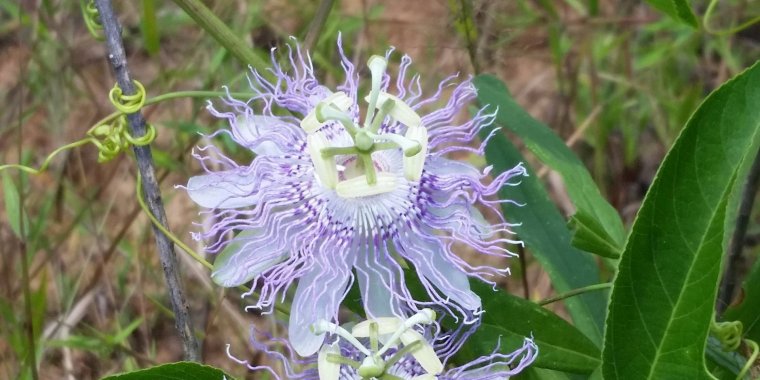| Health / Plants and plant products |
Passionflower
Passionflower is a climbing vine that is native to the southeastern United States and Central and South America.

Passiflora incarnata. Photo: Realtube/Wikipedia
Passiflora incarnata, commonly known as maypop, purple passionflower, true passionflower, wild apricot, and wild passion vine, is a fast-growing perennial vine with climbing or trailing stems.
The Cherokee in the Tennessee area called it ocoee; the Ocoee River and valley are named after this plant, which is the Tennessee state wildflower. The local salamander Desmognathus ocoee in the Tennessee region is also named after the Cherokee word for P. incarnata.
For thousands of years the maypop was a staple food and medicinal plant for the Cherokee and to this day it is a revered piece of their heritage.
This, and other passionflowers are the exclusive larval host plants for the Gulf fritillary and non-exclusive for the variegated fritillary butterflies.
Native peoples of the Americas used passionflower as a sedative. Sixteenth-century Spanish explorers in South America learned of passionflower. The plant was then brought to Europe, where it became widely cultivated and was introduced to European folk medicine.
Today, passionflower is promoted as a dietary supplement for anxiety and sleep problems, as well as for pain, heart rhythm problems, menopausal symptoms, and attention-deficit hyperactivity disorder. It is applied to the skin for burns and to treat hemorrhoids.
How Much Do We Know?
Passionflower is included in pharmacopeias, such as the European and British Pharmacopoeias in which the dried aerial parts of the plant are mentioned. In North America and South America, tea made from the roots is used as a tonic.
A 2013 literature review found that the herb has "a good safety profile". One study found that a daily intake of 800 mg of a dried alcoholic extract, taken over the course of 8 weeks for anxiety, appeared to have been safe.
Passionflower is used as a natural flavoring agent in food manufacturing and is generally recognized as a safe substance (GRAS).
P. incarnata is also listed in the European Register of Feed additives as an animal feed additive.
What Have We Learned?
P. incarnata contains flavonoids and alkaloids, with leaves containing the greatest concentration of flavonoids. Other flavonoids present in P. incarnata include chrysin, apigenin, luteolin, quercetin, kaempferol, and isovitexin.
The main bioactive substances identified in P. incarnata include polyphenols, flavonoids, carotenoids, anthocyanins and other natural antioxidants. The polyphenols mainly belonging to the flavones C-glucoside class are present in P. incarnata and these phenols and flavonoids have high potential antioxidant properties that exhibit significant free radical scavenging activity.
A small amount of research suggests that passionflower might help to reduce nonspecific anxiety and anxiety before a surgical or dental procedure, but conclusions are not definite.
There is not enough evidence to say whether passionflower is helpful for any other health conditions, including attention-deficit hyperactivity disorder, congestive heart failure, insomnia, and stress.
What Do We Know About Safety?
Up to 800 mg daily of a dried alcoholic extract of passionflower has been used with apparent safety in studies lasting up to 8 weeks, but it may cause drowsiness, confusion, and uncoordinated movement (ataxia) in some people. Passionflower used in excessive amounts (e.g., 3.5 grams of a specific extract over a 2-day period) may be unsafe.
Whether it’s safe to use passionflower topically (on skin) is not known.
Possible interactions with following medications:
• Sedatives
• Anticoagulants
• Monoamine oxidase inhibitors
P. incarnata may increase main effects or side effects of medications listed above.
Passionflower should not be used during pregnancy as it may induce uterine contractions. Little is known about whether it’s safe to use passionflower while breastfeeding.
Culinary uses
Passionflower has culinary fruits that may be used for jams, jellies and desserts. The juice is a favorite flavoring in drinks. It can be used as a fresh substitute for its commercially grown South American relative, Passiflora edulis, a related species with similar sized fruit.
The fruit can be eaten by hand; it has a mildly sweet-tart taste similar to an apricot and a pleasant scent when fully ripe.
The Passiflora family have aromatic, sweet fruit that make it highly appreciated for fresh consumption and as a flavoring aid. (National Institutes of Health/Wikipedia)
YOU MAY ALSO LIKE





